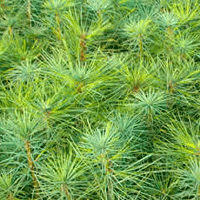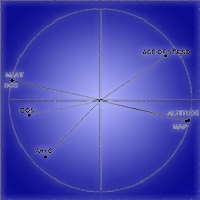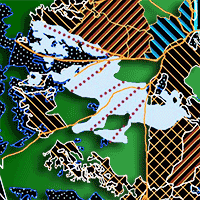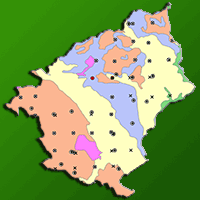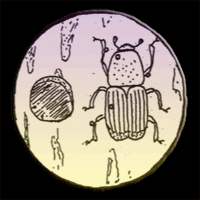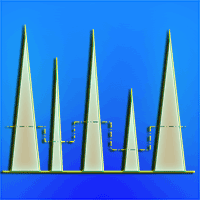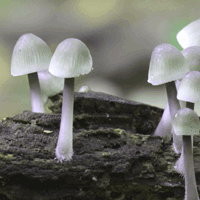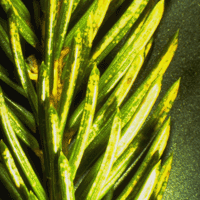
Efficacy of Phlebiopsis gigantea against Heterobasidion conidiospore and basidiospore infection in spruce wood
Lauma Bruna (1) , Darta Klavina (1), Astra Zaluma (1), Kristine Kenigsvalde (1), Natalija Burneviča (1), Vizma Nikolajeva (2), Talis Gaitnieks (1), Tuula Piri (3)
iForest - Biogeosciences and Forestry, Volume 13, Issue 5, Pages 369-375 (2020)
doi: https://doi.org/10.3832/ifor3279-013
Published: Aug 25, 2020 - Copyright © 2020 SISEF
Research Articles
Abstract
Treatment of freshly cut stumps with biological control agents containing Phlebiopsis gigantea spores effectively restricts the spread of new Heterobasidion infections in conifer forests. To test the control efficacy of different P. gigantea strains, conifer stumps or billets cut from tree stems can be artificially infected with asexual Heterobasidion conidiospores or sexual basidiospores or left for natural basidiospore infection. Currently, no information is available about whether the control efficiency of P. gigantea in Norway spruce wood is affected by Heterobasidion spore type. In the present study, the impact of four P. gigantea strains (including the commercial product Rotstop®) on initiation and development of Heterobasidion basidiospore and conidiospore infections as well as the relationship between the area occupied by P. gigantea and control efficacy were analysed in spruce billets. The mean size of the area occupied by P. gigantea was larger, and the efficacy of P. gigantea against Heterobasidion was significantly higher in billets left for natural basidiospore infection compared to treatment with Heterobasidion conidiospore suspension. The control efficacy against Heterobasidion infection was high, although only a small area of the billet surface was occupied by P. gigantea and even when there was no visible discoloration caused by P. gigantea infection on wood surfaces.
Keywords
Authors’ Info
Authors’ address
Darta Klavina 0000-0002-1455-9062
Astra Zaluma 0000-0003-2980-4435
Kristine Kenigsvalde 0000-0002-2761-2651
Natalija Burneviča
Talis Gaitnieks 0000-0003-1951-4426
Latvian State Forest Research Institute Silava, Riga street 111, Salaspils, LV-2169 (Latvia)
University of Latvia, Raina boulevard 19, Riga, LV-1050 (Latvia)
Natural Resources Institute Finland LUKE, Latokartanonkaari 9, 00790 Helsinki (Finland)
Corresponding author
Paper Info
Citation
Bruna L, Klavina D, Zaluma A, Kenigsvalde K, Burneviča N, Nikolajeva V, Gaitnieks T, Piri T (2020). Efficacy of Phlebiopsis gigantea against Heterobasidion conidiospore and basidiospore infection in spruce wood. iForest 13: 369-375. - doi: 10.3832/ifor3279-013
Academic Editor
Alberto Santini
Paper history
Received: Nov 01, 2019
Accepted: Jun 17, 2020
First online: Aug 25, 2020
Publication Date: Oct 31, 2020
Publication Time: 2.30 months
Copyright Information
© SISEF - The Italian Society of Silviculture and Forest Ecology 2020
Open Access
This article is distributed under the terms of the Creative Commons Attribution-Non Commercial 4.0 International (https://creativecommons.org/licenses/by-nc/4.0/), which permits unrestricted use, distribution, and reproduction in any medium, provided you give appropriate credit to the original author(s) and the source, provide a link to the Creative Commons license, and indicate if changes were made.
Web Metrics
Breakdown by View Type
Article Usage
Total Article Views: 38279
(from publication date up to now)
Breakdown by View Type
HTML Page Views: 32999
Abstract Page Views: 2810
PDF Downloads: 1864
Citation/Reference Downloads: 5
XML Downloads: 601
Web Metrics
Days since publication: 1936
Overall contacts: 38279
Avg. contacts per week: 138.41
Citation Metrics
Article Citations
Article citations are based on data periodically collected from the Clarivate Web of Science web site
(last update: Mar 2025)
Total number of cites (since 2020): 6
Average cites per year: 1.00
Publication Metrics
by Dimensions ©
Articles citing this article
List of the papers citing this article based on CrossRef Cited-by.
References
Preliminary results of Norway spruce stump treatment with Hypholoma fasciculare and Phlebiopsis gigantea in an Austrian Alpine protection forest. In: Proceedings of the “12th International Conference on Root and Butt Rots of Forest Trees” (Garbelotto M, Gonthier P eds). Berkeley (CA, USA) - Medford (OR, USA) 12-19 Aug 2007. The University of California, Berkeley, CA, USA, pp. 192-194.
Gscholar
A field trail testing Phlebiopsis gigantea as a biocontrol agent for Heterobasidion root disease in the southeastern United States. In: Proceedings of the IUFRO Working party 7.02.01 “Root and Butt Rots of Forest Trees” (Capretti P, Comparini C, Garbelotto M, La Porta N, Santini A eds). Firenze - San Martino di Castrozza (Italy) 4-10 Sept 2012. Firenze University Press, Firenze, Italy, pp. 183-184.
Gscholar
Untersuchungen zur biologischen Bekämpfung von Heterobasidion annosum an Fichte (Picea abies) mit antagonistischen Pilzen. II. Interaktionstests auf Holz [Investigations on biological control of Heterobasidion annosum in Norway spruce with antagonistic fungi. II. Interaction experiments in wood]. European Journal of Forest Pathology 14 (3): 137-153. [in German]
CrossRef | Gscholar
Biological methods of control. In: “Heterobasidion annosum: Biology, Ecology, Impact, and Control” (Woodward S, Stenlid J, Karjalainen R, Hüttermann A eds). CAB International, Wallingford, UK, pp. 235-258.
Gscholar
Simulated stump treatment experiments for monitoring the efficacy of Phlebiopsis gigantea against Heterobasidion annosum. In: Proceedings of the IUFRO Working party 7.02.01 “Root and Butt Rots of Forest Trees” (Laflamme G, Bérubé JA, Bussières G eds). Quebec (Canada) 16-22 Sept 2001. Natural Resources Canada, Canadian Forest Service, Ottawa, ON, Canada, pp. 206-210.
Gscholar
Control of Heterobasidion annosum by stump treatment with “Rotstop”, a new commercial formulation of Phlebiopsis gigantea. In: Proceedings of the IUFRO Working Party S2.06.01 “Root and Butt Rots” (Johansson M, Stenlid J eds). Wik (Sweden) - Haikko (Finland) 9-16 Aug 1993. Swedish University of Agricultural Sciences, Uppsala, Sweden, pp. 675-685.
Gscholar
Infection, growth rate, and competitive ability of Fomes annosus in inoculated Pinus echinata stumps. Phytopathology 54 (5): 556-561.
Gscholar
Stump treatment experiments against Heterobasidion in the Italian Alps. In: Proceedings of the IUFRO Working party 7.02.01 “Root and Butt Rots of Forest Trees” (Laflamme G, Bérubé JA, Bussières G eds). Quebec (Canada) 16-22 Sept 2001. Natural Resources Canada, Canadian Forest Service, Ottawa, ON, Canada, pp. 176-180.
Online | Gscholar
Occurrence and impact of the root-rot biocontrol agent Phlebiopsis gigantea on soil fungal communities in Picea abies forests of northern Europe. FEMS Microbiology Ecology 81 (2): 438-445.
CrossRef | Gscholar
Stump treatment against Heterobasidion with Phlebiopsis gigantea and some chemicals in Picea abies stands in the western Alps. Forest Pathology 35 (5): 365-374.
Gscholar
Chemical control of Heterobasidion annosum. In: “Heterobasidion annosum: Biology, Ecology, Impact, and Control” (Woodward S, Stenlid J, Karjalainen R, Hüttermann A eds). CAB International, Wallingford, UK, pp. 259-282.
Gscholar
Spore dispersal and infection. In: “Heterobasidion annosum: Biology, Ecology, Impact, and Control” (Woodward S, Stenlid J, Karjalainen R, Hüttermann A eds). CAB International, Wallingford, UK, pp. 105-113.
Gscholar
Regional differentiation in Heterobasidion annosum. In: Proceedings of the IUFRO Working Party S2.06.01 “Root and Butt Rots” (Johansson M, Stenlid J eds). Wik (Sweden) - Haikko (Finland) 9-16 Aug 1993. Swedish University of Agricultural Sciences, Uppsala, Sweden, pp. 243-248.
Gscholar
Effect of stump treatment on transfer of Heterobasidion annosum root rot in Norway spruce. In: Proceedings of the IUFRO Working party 7.02.01 “Root and Butt Rots of Forest Trees” (Laflamme G, Bérubé JA, Bussières G eds). Quebec (Canada) 16-22 Sept 2001. Natural Resources Canada, Canadian Forest Service, Ottawa, ON, Canada, pp. 160-169.
Gscholar
Testing of Rotstop on Sitka spruce, Douglas-fir and larch. In: Proceedings of the IUFRO Working party 7.02.01 “Root and Butt Rots of Forest Trees” (Laflamme G, Bérubé JA, Bussières G eds). Quebec (Canada) 16-22 Sept 2001. Natural Resources Canada, Canadian Forest Service,, Ottawa, ON, Canada, pp. 217-218.
Gscholar
Spread of S and P group isolates of Heterobasidion annosum within and among Picea abies trees in central Lithuania. Canadian Journal of Forest Research 28 (7): 961-966.
Gscholar
Impact of biological (Rotstop) and chemical (urea) treatments on fungal community structure in freshly cut Picea abies stumps. Biological Control 31 (3): 405-413.
Gscholar

